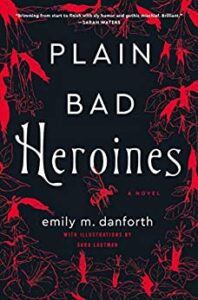Plain Bad Heroines by Emily M. Danforth illustrated by Sara Lautman
William Morrow & Company, 2020
ISBN-13: 978-0062942852
Available: Hardcover, Kindle edition, audibook, audio CD ( Bookshop.org | Amazon.com )
Emily M. Danforth, author of the YA novel The Miseducation of Cameron Post, stretches her boundaries in this unsettling, haunted novel that reveals a buried history of queer romance and horror and some seriously creepy hornets.
The story moves smoothly from events in 1902 that led to the deaths of three students at the Brookhants School for Girs, tied to an uninhibited and shocking memoir by openly bisexual feminist Mary McLane, to a present day where author Merritt Emmons has written a book about the deaths that is about to be made into a sapphic “Blair Witch” style horror movie.
Two of the girls who died were co-founders of a club called The Plain Bad Heroines, which admires Mary’s unapologetic attitude, are found dead in the woods with a copy of the book, attacked by a swarm of hornets in an orchard of rotting fruit. The third acquires it after their deaths and is literally poisoned by reading it near a plant in the campus greenhouse where she is caretaker. The headmistress confiscates it, convinced that it is cursed. As the students abandon the school, both the headmistress and her relationships begin to disintegrate, and trapped almost alone in a snowstorm, it’s hard to tell how much of a grip on reality she has left. She’s also left remembering her college days, where a love affair led to her eventual inheritance of Brookhants, chosen by her husband because of its reputation as a spiritually important location, in a very strange manner.
The horror movie based on Merritt’s book will star the popular actress Harper Harper and the less well-known actress Audrey Wood. Merritt initially is starstruck by Harper and they hit it off; her interactions with Audrey are more negative. The movie will be filmed at the actual Brookhants School and on the grounds, adding atmospheric creepiness. Once the filming starts, it seems nothing can go right– it’s almost like the production is cursed. This leaves Harper, Audrey, and Merritt, a lot of time for exploration on the Brookhants estate. Black apples, rotting vegetation, and ominous swarms of hornets in the woods ratchet up the tension, and eventually the story behind the Brookhants curse is revealed.
This is a doorstop of a book. After its tense begining, it slows down for some time and, had I not known there would be a payoff, I might have set it down. I think a large chunk of the Hollywood segment could have been easily eliminated to slim it down. This is where a lot of the present day characters’ personalities are established, and Merritt’s romantic interests start to develop, but it is just too drawn out.
Danforth isn’t subtle about centering lesbian and bisexual characters. It is even a point of contention in the casting of the movie, where Merritt objects to Audrey playing a lesbian role, assuming she must be straight, to have Audrey come out and say she’s bisexual. The headmistress’ memories of inheriting the school are all related to the romantic love she and her partner had for each other. even as she turns on her.
Plain Bad Heroines is also about as metafictional as you can get; it’s a fictional story inspired by a book by a real person, containing illustrations and images of what I’m pretty sure are news articles about the book, that a fictional author has written a fictional nonfiction book about, that is being made into a fictional movie being filmed found-footage style, as if it is nonfiction. Both the director and Harper Harper use social media to affect the narrative, so Harper’s Instagram posts document the movie shoot and all of its “cursed” problems for her followers, creating a Blair Witch effect of convincing the audience for the movie that the haunting is real. Even the people around Audrey and Merritt are in on the gaslighting, so that none of them know whether they can trust each other or reality. It’s clever, and the unreliability of the people around them and the way the reader knows the three women are being manipulated is distracting, but it doesn’t detract from the sense of atmospheric creepiness, dread, and tension, with hornets and rotting vegetation always around. You will never feel the same about hornets after reading this book.
Danforth actually has an author’s note where she discusses her discovery of Mary Maclane in researching hidden sapphic history, and that she wanted to bring that to light through Plain Bad Heroines. I never had heard of her and I found this fascinating. Unlike The Miseducation of Cameron Post this is not a YA novel, although it might be appreciated by some older YA readers, but certainly it is an original book with plenty of dread and some well-drawn lesbian and bisexual characters that will draw in readers of historical and metafictional horror, Hollywood, and haunted houses. It won’t be for everyone, but this book will certainly find its audience. Recommended.
Contains: violence, murder, body horror, sexual situations, insects







Follow Us!